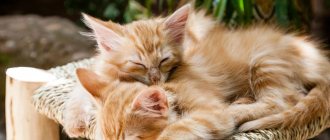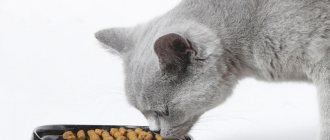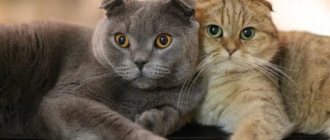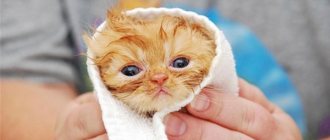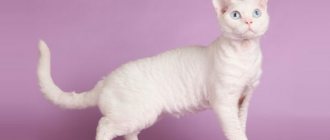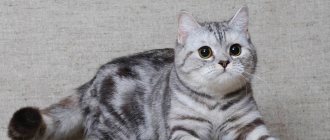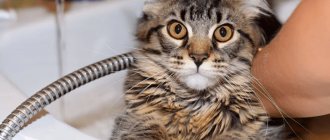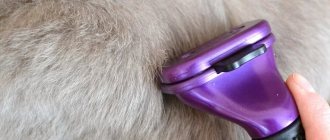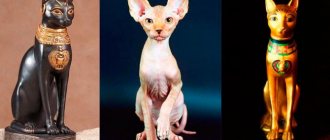About the origin of the breed: history and legends
The homeland of Siamese cats is the Kingdom of Thailand. It was once called Siam. Local felinologists (specialists in the study of cats) say that the breed has been known for more than 600 years. However, outside the state they knew nothing about it until the last quarter of the 19th century. In ancient Siam, these cats were considered temple animals and were worshiped. Religious Siamese believed that graceful animals accompanied the souls of the dead to the afterlife.
Modern Siamese are lean and graceful
The Siamese cat managed to get into the biblical legend of Noah's Ark. According to legend, the first Siamese kitten was born thanks to the love of a beautiful lioness and a courageous male monkey. Therefore, the fruit of their love and its descendants are smart and dexterous like a monkey, and also fearless, like lions. By the way, there is some truth in this mythical story. Biologists believe that the Siamese breed was the result of crossing two species. But the primates did not participate in this. Domestic cats brought to Asia made love with local wild cats.
Blue-eyed cats lived in the royal palace and the chambers of the rich and noble people of Siam. At the end of the 19th century, they settled at the courts of European monarchs. The Siamese king decided to give several pairs of cats to his colleagues. In 1884, the first seals of an unprecedented breed arrived in London. From this time on, the triumphal march of the Siamese across Europe began.
Elegant cats were very fond of English queens and their loyal subjects. At the very first exhibition, the Siamese became the favorites and for a long time did not give primacy to others. At the very beginning of the 20th century, the “Siamese Cat Lovers Club” appeared in Great Britain, and the first breed standard was developed. It is significantly different from the modern one. The first standard color is a soft beige body and dark brown, almost black, markings (seal point). English breeders are still considered trendsetters in breeding this breed.
Later, the Siamese conquered other European countries, Russia, and then the United States. New “colors” have appeared: white-blue, cream-chocolate, white-lilac.
The new Siamese breed standards are very different from the previous ones
50 years later, the breed standards were revised: modern colors were legalized, the physique of the Siamese cat changed. The purebred animal has a narrow wedge-shaped head, decorated with wide-set large ears, a light and long body, and graceful paws.
Video: history and modernity of the Siamese breed
Health and illness
Siamese often suffer from genetic diseases, which is caused by shortcomings in the process of breeding the breed. Initially, the emphasis was on appearance, and the breeders practically did not take care of the animal’s health.
Individuals from the same litter were often used for crossing, which caused the development of mutations in genes. Modern scientists have done everything possible to eliminate this problem, but kittens with hereditary pathologies are still born.
The following congenital pathologies are found only in this breed:
- Strabismus. Due to an improperly developed eyeball, vision problems arise. Pathology leads to the fact that Siamese see the world around them in a flat image.
- Tail with a bend. This is a sign of a breed defect, expressed by curvature of the vertebrae. With this pathology, the nerve endings are pinched, which is accompanied by constant pain. Animals with this problem may become aggressive.
The wedge-shaped head and jaws allow cats to swallow food without chewing. Such food intake leads to the formation of plaque and stones on the teeth, and the development of periodontal disease. To avoid this, it is necessary to choose food made in large pieces, and also carefully monitor the condition of the animal’s oral cavity.
Trusting Siamese cat.
Due to the narrow wedge-shaped head and lack of undercoat, pets often suffer from respiratory diseases. Therefore, hypothermia, drafts, and cold water for drinking are contraindicated for cats.
Common diseases of the breed:
- Glaucoma. Caused by increased eye pressure, it can lead to retinal atrophy and the development of blindness.
- Amyloidosis. Accumulation of protein in the kidneys and liver, against which chronic failure of these organs develops.
- Hyperthyroidism. Thyroid dysfunction, which is manifested by weight loss, thirst, and increased appetite.
- Bronchial asthma.
- Aortic stenosis. A congenital heart disease in which the aortic opening is narrowed, leading to problems with blood circulation.
- Expansion of the heart. The pathology causes heart failure.
Prevention methods
When choosing a kitten from a breeder, you should ask him for documents about the pet itself and its parents, as well as the results of genetic testing.
Mandatory procedures:
- routine vaccinations;
- treatment for parasites;
- taking anti-helminth medications;
- taking vitamins.
If the owner’s plans do not include breeding, then in the first year of life it is necessary to spay/neuter the animal.
Siamese cats are characterized by good health, provided they are properly cared for. Life expectancy can reach 20 years. Upper respiratory tract infections pose a danger to animals. They need to be kept warm and comfortable. Some of them are prone to genetic diseases. Therefore, when buying a cat, you need to find out from the owner whether there were any problems with its parents.
Previously, tail defects were considered a distinctive feature of Thai cats. Now this is considered a disadvantage. But it is harmless and unnoticeable. The nodule can only be felt. Some kittens are born cross-eyed. This phenomenon is rare and lasts up to a year. It happens that the problem remains, but this does not bother the cats themselves.
Description of Siamese cats: appearance, character, behavioral characteristics
Over the course of a century and a half, certain characteristics have developed that distinguish Siamese cats. The first thing that catches the eye of an inexperienced lover of these animals is their special color with dark-colored limbs, muzzle and ears, as well as a sophisticated silhouette. Another breed characteristic is bright blue or dark blue eyes. But few people, except breeders and felinologists, know that a purebred Siamese should have very large ears.
Large ears have become one of the most noticeable characteristics of the Siamese breed.
Breed standards
A real Siamese cat is a small and harmoniously built animal:
- slender, flexible figure and well-developed muscles, cats are larger than female cats;
- the body is elongated, graceful;
- the limbs are proportionally high, the tips of the paws are elegant: oval and small;
- the thin tail resembles a whip, approximately equal in length to the body;
- the slender neck is crowned by a small head in the shape of an elongated wedge;
- the lines of the cheekbones are straight without bends in the vibris;
- low-set ears are an extension of the head: if you connect the tip of the nose and the tops of the ears with lines, you get a triangle with equal sides;
- The ears are large and wide at the bottom.
Siamese have a slender, elongated body
The head of a Siamese cat in profile looks clear and straightforward. There are no transitions or depressions on the bridge of the nose. The chin and tip of the nose are on the same vertical line. Almond-shaped eyes are set slightly askew (however, squint is a defect). The color of the iris is any shade of blue. The rich, bright color is especially appreciated.
The Siamese's head is shaped like a wedge.
The Siamese's short, shiny coat lies tightly to the skin. These southern beauties have no undercoat. The color of the fur coat is characteristic: on the body it is white or light monochromatic, turning into dark markings on the paws, tail, ears and into a mask on the face. Moreover, the ear points and the mask should not completely merge.
The special Siamese coloration - darker color on the ends of the body - is called acromelanism. This is a genetically inherent feature of pigmentation, in which the intensity of color depends on the temperature of parts of the body: the lower it is, the darker the color. If a Siamese cat is kept in cool conditions, the markings will be larger. Kittens are born without points because the mother's womb maintains an even temperature throughout the body.
The color intensity of the points changes with age
Slight darkening on the sides is allowed if they are the same shade as the points. The main color options for Siamese cats:
- the base tone is cream or light brown, the markings are black-brown (seal point);
- snow-white color turning into light gray, deep dark blue markings (blue point);
- ivory body and coffee-milk points (chocolate point);
- the basic tone is white, sometimes slightly yellowish, the markings are gray with a lilac tint, the paw pads and nose are lilac-pink (lilac point);
- the body is white, the limbs are reddish-gold or apricot-colored, the nose is bright pink (red point);
- white-cream color on the body, slightly darker on the back and sides, intense cream markings (cream point);
- creamy yellow coat on the body, clearly defined ash-brown points, nose, paw pads, edges of the eyelids gray-pink (caramel point);
- white body with a slight yellowish tint, brown markings, nose and eye rims (cinnamon point);
- on the body there is magnolia-colored fur, pinkish-brown spots, bright blue eyes (von point).
In kittens, points appear over time
There are also tortie- and tabby-point cats. They are standard colors, but the former have dark markings in the form of spots, and the latter have stripes.
The American continent has its own beauty standards for Siamese cats. But they differ from European ones not so much. Siamese from America are smaller, with lighter bones. Their fur is thinner and lies closer to the skin, and their eyes are more rounded than those of European cats.
Reasons for disqualification
There are a number of shortcomings due to which a kitten from purebred parents will be excluded from the prize-winners and even exhibitors. He and his offspring will not be considered true Siamese. What is unacceptable:
- dark spots on the chest and groin area;
- white toes, spots;
- the iris of the eyes is not blue or light blue;
- malocclusion;
- hooked or broken tail;
- extra fingers;
- lack of weight, emaciated appearance.
Characteristics of a Siamese
Siamese cats are aristocrats in every way. In addition to his sophisticated appearance, he has an intelligent and sociable character and a playful disposition. Breed experts say that Siamese are smart and resourceful. They captivate people with their devotion and desire to communicate.
By nature, this is a companion cat - something between an independent person and a bosom friend. Such a cat-dog will purr peacefully next to you, caress you, and then, like a dog, will bring back the toy you threw, and maybe even stand up for the owner. Siamese are an excellent choice for those who dream of a dog, but cannot devote time to long walks. By the way, these cats treat walking favorably. Especially if you accustom them to the street from childhood.
Siamese cats can become walking partners
Our Siamese cat Lady loved hanging out together. And only at first they took her out in a harness with a leash. This was not a necessity, but a safety measure. So that the animal does not get hurt by dogs or get hit by cars. As soon as we found ourselves in a quiet place, the leash was removed. And the Siamese walked by itself, but never strayed far from us, always followed close by. In the summer, trips sometimes lasted one and a half to two hours. Even at a young age, Lady did not try to escape. But our puppies, getting carried away, forgot about obedience and could hide in an unknown direction.
Siamese love the company of people, they ask to be played with
The increased sociability and mobility of Siamese dogs has a downside. These cats do not tolerate loneliness. They get bored and misbehave if they don’t find anything else to do when their owner is not at home. To prevent destruction, you need to provide your pet with entertainment. If you get a Siamese, make sure she has a variety of toys. Show her how to play and she will have fun herself when she is alone. Better yet, take a second kitten or puppy into your home. Siamese get along well with Oriental cats and dogs. They often take on the role of leader, especially if the dog is smaller or younger. For families with children, the Siamese cat is also a good option. They should get along well.
Siamese cats are friendly to all household members
Fans of this breed urge not to believe the popular opinion about the aggressiveness of Siamese cats. True Siamese are affectionate and delicate. This is enshrined in the standard.
Siamese cats play well with each other
Another distinctive feature of the breed is talkativeness. The Siamese express their opinion on any matter. They are not shy about reminding you about lunch time, demanding that you play with them, and showing you how much they love you. And for each case there are different intonations - a persistent meow, a gentle grunt, a hoarse song. Such talkativeness usually evokes sympathy. But the primitive screams of some Siamese during sexual hunting, which can last for days, can only be withstood by the most patient owner.
Blue-eyed cats love to speak out
Siamese or Thai: how to distinguish between breeds
Cats of these breeds are often confused. There is nothing surprising about this. They have the same homeland, similar fur and eye color, and have common character traits. But there are also many differences. And if you look closely, you can clearly see them. Siamese cats are more petite and elongated than the strong, muscular Thais. Siamese have everything refined and angular: long legs and tail, a wedge-shaped muzzle with large, pointed ears. Thai cats have soft and smooth shapes: oval paws, a rather thick tail, a rounded head without sharp lines, medium-sized ears with rounded tips. It is incorrect to say that any of these breeds is better. Each has both positive and negative qualities, ardent fans and opponents.
The Siamese has large ears and an elongated muzzle (left), while the Thai cat is more rounded
Opinions about the Siamese breed
These are very beautiful cats and Siamese cats. Some say that representatives of this breed are very angry, but this is not true. My cat's name is Sema, he is already about 6 months old. On the contrary, he is kind and affectionate. In addition, he easily made friends with the dog.
Egevi4ka13
https://otzovik.com/review_5253970.html
This breed is one of my favorites. It’s not true that they are vindictive and wild. They are incredibly smart and loyal to their owner. And they don’t require any special care at all, they don’t have any fur at home, they rarely shed, they have excellent health, no problems with the genome. It’s better to take a small kitten, and not an adult animal, he will get used to you much easier and it will be easier for you to ingratiate himself into his trust, so to speak)) although there is experience in meeting and communicating with an adult, they are sociable, but they choose favorites in the family and trust them with their whole cat soul ) Well, it’s a very good breed of cats, take it, you won’t regret it, and they generally look like they’re killing intellectuals and aristocrats. I’m for this breed!!! They’re lovely!!!
LinaLina
https://irecommend.ru/content/umneishaya-poroda-nezavisimaya-i-gratsioznaya-kontaktnaya-i-predannaya-kak-sobachka
Siam has been living with me for 15 years. When a kitten is very active and loves to play with everything that moves or can be set in motion (including the drum of a washing machine), you MUST buy the cat a scratching post, otherwise all the sofas will be fringed! *tested on my own*. I would like to note that Siamese cats are NOT vindictive! Yes, they may be offended and take revenge, but that doesn’t count. Many cats do this. My cat has a sense of justice. That is, if my parents scolded me, he would stand between me and them and meow and hiss. if someone is upset, he will always come and feel sorry, ask “meow?” *says what happened*, listens carefully, rubs your nose with your ear..., gives advice (usually a short “meow”). He is also very sociable, you need to talk to him every day. he understands perfectly well when people turn to him, answers questions, says something, complains, sometimes.
Naru
https://otzovik.com/review_274447.html
I would like to dispel another misconception regarding Siamese cats. Color-point cats are often called Siamese, but they have nothing to do with real Siamese! This doesn't make them worse, they're just different! Another misconception about vindictiveness and bad character. Absolute nonsense! I say this as the owner of several cats of this breed. These animals have a wonderful character, they are very friendly! They are very attached to people, these are not the cats that “walk on their own”! They need human company. They love to “help” their owner in everything and participate in all his affairs)) Siamese and Orientals are very sociable, express their emotions with their voices, but never “chat” without reason. Animals are very playful, remain active until old age, love to run around happily in the company of their relatives, but also take people into their games with great pleasure. They get very bored when left alone and are incredibly devoted to their owner.
LaK
https://irecommend.ru/content/otzyv-o-nastoyashchikh-siamakh-ne-o-koshkakh-okrasa-kolor-point
We have a Siamese. Refusal without documents. Affectionate - horror! He adores people, runs ahead of everyone to greet guests, rubs against them, pets them. Treats children very well. But he loves his striped, tailed friend of the cat tribe more than us. Now she has become talkative, but before that she was silent. Apparently I've gotten used to it.
buenacabeza
https://www.u-mama.ru/forum/family/pets/530129/index.html
Real Siamese cats are mega-affectionate creatures. Any manifestations of aggression in cats lead to the disqualification of such an animal as a producer. Affectionateness is a breed trait.
Terra_ra
https://irecommend.ru/content/nastoyashchii-siamskii-kot-ne-taets
Video: do not confuse Thai and Siamese cats
Appearance (standards)
Dimensions
Siamese cats are usually light in weight, between 3 and 5 kg.
Head
The Siamese's head is shaped like a triangle.
Limbs and tail
The animal's legs are long. The tail is thin and also long. It tapers slightly towards the tip.
Coat and color (types of color)
Siamese cats are considered shorthaired. In the photo you can see that their fur is very shiny. It fits quite tightly to the animal's body. There is no undercoat.
There are quite a large number of animal colors:
- blue point. Another name for it is blue. This color is white with a bluish tint;
- seal point. Dark brown color;
- Lilac Point. Pink or purple;
- chocolate point. Markings range from chocolate to black;
- tabby point. Includes brindle or striped;
- red point. Red color or shades of apricot;
In addition to these colors, there are others.
The first 4 colors were recognized by the Americans, while the Europeans increased their number to 18.
Ears
The Siamese cat has ears with a fairly wide base. Moreover, larger ear sizes are welcome.
Eyes and nose
Looking at a photo of a Siamese cat, one simply cannot help but notice its extraordinary eyes. In addition to their sky blue color, they also attract with their almond-shaped shape.
Representatives of the Siamese breed are often born with strabismus.
Features of the Siamese cat
It is difficult to confuse this breed with any other, it is so remarkable and memorable. Its distinctive feature is its specific color, in which the body of the animal has one, lighter color. The points, that is, the muzzle, tail and paws, have a different, darker or even black color.
Siamese cats give birth to completely white kittens. Only after some time their color begins to become darker.
Siamese have a specific, very interesting character and are very intelligent. This is an animal that knows its worth.
Purchasing a kitten
If your goal is to participate in exhibitions and breed Siamese cats, choose your pet carefully. The future winner must be of high blood, from titled parents and reliable breeders. The owners of a mother cat or cattery are required to issue a certificate indicating the date of birth of the kitten, the names of its and its parents, breed and color. Later this document is exchanged for a pedigree. The price of Siamese kittens, which will become participants in exhibitions and producers, reaches 800 euros and more. The more titles parents have, the more expensive their offspring will be.
The future champion must have high-born ancestors
If you need a cat for the soul and games, the costs will be much more modest and the choice will be easier to make. You can buy a kitten from a breeder or in a nursery, then it will definitely have all the characteristics of the breed. But you have the right not to be given documents if the animal will not be exhibited. The price of a small Siamese in this case will be 10–15 thousand rubles, and sometimes less.
There are nurseries in Russia where they seriously study Siamese and other oriental breeds. A list of some and their coordinates can be found here.
Criterias of choice
The potential winner and prize-winner of cat shows is chosen meticulously. It is important to exclude any grounds for disqualification. Already at a young age it is clear what the baby will become. By this time, dark markings should appear, whether the tail is straight, the number of fingers, what color of the eyes - everything is visible. When choosing a kitten, check the criteria for compliance with breed standards. And, of course, the future pet should evoke sympathy from the owner. It is difficult to raise a champion without mutual love.
When purchasing a kitten, you need to understand what your goals are.
A kitten that is bought for pleasure does not need to be subjected to strict inspection. The main selection criteria will be character and health. Do not choose a pet at the market, only at home. There you will see how a cat is kept, take a good look at the babies and their mother. Pay attention to the condition of the kitten's fur, eyes, and ears. If something worries you, refuse to purchase.
The Siamese cat was our first pet. In the apartment of the mother cat's owners, we saw kittens hanging in a bunch right on the wall (thick vinyl wallpaper was in fashion at that time). It seemed funny. But a day later the little Siamese began to hang on our wallpaper. And we had no time for fun. It took a long time to wean her off the bad habit.
Age of kitten for moving to a new family
Experts do not recommend purchasing a kitten younger than 2.5, or preferably 3 months. Kids react painfully to parting with their mother and moving. Usually by 3 months they get used to independence, know how to eat and are toilet trained. Check with the cat's owners what they fed the kittens, and at first stick to the same diet. By this age, little Siamese should already have received mandatory vaccinations and deworming.
Preparing to maintain a home
It is necessary to create favorable conditions for the new family member. You need to take the baby away from the mother no earlier than 1 month after birth, but the later the better. Maintain the temperature at home at least 25 degrees, remove drafts, these animals love warmth. You need to buy a place where the kitten will rest. This could be a bed or a house, buy toys, because the Siamese cat is playful. Various shampoos for bathing, scissors for trimming nails, a comb for combing out fur, bowls for food and water, and a tray will come in handy. It is necessary to install at least one scratching post to protect the new wallpaper. You need to decide what to feed the animal. Remove small parts from accessible places and fence off wires.
Keeping a Siamese cat
Keeping a Siamese is much easier than long-haired or hairless cats: caring for their coat is simple, and the Siamese will not freeze and sweat like a sphinx. However, there are difficulties with feeding.
Nutrition
Siamese cats are quite selective when it comes to food. Not every food is to the liking of these aristocrats. If the diet is not chosen correctly, they can suffer from allergies, diarrhea, and sometimes obesity. To avoid such problems, consult the breed's breeders, find out what they fed the kitten and what their adult pets prefer.
Quantity and composition of feed
Experts advise giving your baby only natural food for up to one and a half to two months. During this period he is still breastfed. Cream diluted with boiled water and baby curds are suitable as complementary foods. From about 6 weeks, offer the kitten soaked dry food, which is recommended for this age. Drinking water must be freely available. You cannot limit your kitten's diet. The younger he is, the greater the number of feedings should be: up to 2 months of age - 5-6 times, up to 4 months - 4 times. And only after six months switch to 2 meals a day.
For adult animals, give professional food and canned food (Hills, Eagle Pack, Ekanuba, Royal Canin, Yams, Pro Plan). They provide the cat with all the necessary substances. The optimal amount of food per day is indicated on the packaging. Finding a balanced natural diet is more difficult. However, there are Siamese who categorically refuse “crackers”. Feed them boiled chicken and canned food for children. Beef and lamb should be served raw, but pork is completely prohibited. Be careful with dairy products. Many adult cats cannot digest lactose, so milk causes diarrhea. But include cottage cheese or fermented milk products in the menu.
Not all Siamese cats eat dry food.
The role of a balanced diet and the health of the Siamese cat
Don’t think that your cat is expecting gastronomic variety and pickles. If she likes the products, she feels good, do not introduce something new into her diet unless necessary. But when feeding naturally, take care of vitamin and mineral complexes. Let's take them in courses. The main thing in the nutrition of Siamese cats is not to overfeed them in order to prevent obesity. Neutered animals are especially prone to overeating. But the cat should also not be allowed to become exhausted. If her appetite is normal and her figure is painfully thin, parasites may be to blame. Deworm the animal. And if this does not work, contact your veterinarian.
Siamese should not gain excess weight
Appearance care
Caring for Siamese is not difficult. They themselves cope well with this task. Cats of this breed have no undercoat and short fur. Brush your pet every three to five days or more often during shedding. It is better to use a brush with natural or rubber bristles for the procedure. And then you can polish the fur with a piece of suede. Manipulations with the fur coat are needed not so much by the cat itself, but by the owner, in order to maintain cleanliness in the house.
Even a child can handle caring for a Siamese
Bathe Siamese cats only when necessary - when they are dirty or it is too hot and you need to cool the animal down. Some representatives of the breed are good at water procedures. Pay special attention to the Siamese's gorgeous ears. They must be periodically inspected and deposits removed with a cotton swab moistened with oil. Clean eyes are an indicator of a cat's health. But they should also be wiped from time to time.
Teeth do not need care if the cat eats dry food. She chews the crackers and peels them. And with a natural diet, monitor their condition - wipe regularly with a damp swab, remove tartar from the veterinarian.
The owner must keep the Siamese ears clean
Cat litter and walks
Siamese cats are clean, they quickly learn to relieve themselves in their toilet. But there are also difficulties. To avoid them, find out from the owners of the mother cat what kind of litter their animals are used to. Choose a spacious litter box so that your cat doesn’t feel too cramped.
It took our Siamese cat quite a long time to get to her new home. But when we finally put the kitten down on the floor, he immediately began to look for the toilet. Fortunately, we took care of the amenities in advance. Having found the tray, the pussy did everything it was supposed to with relief. And we, fascinated by her aristocratic manners, immediately gave her a name - Lady. Later, the aristocrat showed that the toilet is not the main thing. More than once she hung from the curtains, tore up the wallpaper, stole sausage from the table, and hunted birds on her walks.
Beginning Siamese owners complain that their pets require constant attention. If there is not enough of it, the cat begins to disrupt the order. To prevent this from happening, play with him more often. Another way to calm a raging beast is to make him a Siamese or Oriental friend. Playing together will distract cats from damaging property. If this is not possible, try walking with your pet. The street provides so much information and tires the cat so much that for several days after the walk he behaves calmly. Some cat owners claim that their Siamese loves exercise so much that they themselves bring a leash and harness.
Walking together brings cats and their owners closer together
Animal character
From the first day, the Siamese cat chooses its owner. No matter how large the family that becomes the owner of a kitten is, there will be only one owner for the animal. It is not clear what rules the Siamese follows, but his choice does not at all depend on who feeds him and cleans up after him.
The animal becomes very attached to the owner, it can follow on his heels and try to participate in his affairs, happily running towards him after separation. When bored, the pet can sleep on the owner's bed. You need to take these points into account when getting a Siamese cat. Because if the owner cannot give her proper attention, she will become sad and may become depressed
Cats of this breed are characterized by manifestations of jealousy. They get along quite difficult with other pets. The only exceptions are representatives of their breed.
The cat has a cheerful character. She is always very active, energetic and will happily take part in any game started by her owner. In the absence of initiative on the part of a person, the animal is capable of entertaining itself by chasing balls or even candy wrappers around the apartment. Siamese are cats that simply hate being alone. When leaving or leaving home for work, you need to try to keep them busy with something or get them a companion, otherwise in moments of sadness the animal will find fun and begin to methodically destroy the interior of the owner’s house.
A feature of this breed is curiosity. You can be sure that the new family member will immediately explore every corner of the house to which he was brought. Thanks to this trait, the Siamese cat is quite trainable. It will not be difficult for her to perform simple tricks. Very quickly the animal remembers its name and responds to it.
Contrary to all existing myths, the Siamese cat is not at all aggressive. Yes, she has a peculiar character, but aggression is unusual for him.
Is it worth having a pet in a house where children are growing up? If the children are not very small, the Siamese cat will make friends with them and quickly find a common language. Her only condition is a good attitude towards her and the absence of aggression on the part of the child. If there is a baby in the house, it is better to hold off on buying a Siamese. The baby, without understanding, can harm the pet. And the Siamese cat will definitely respond to the insult.
Siamese have a loud voice and use it very often. They are the most talkative of all cat breeds. Consider this feature if you are annoyed by a cat's meowing.
They adapt very well and quickly to new conditions if they move.
Cats of this breed have well-developed intuition.
Often this ability helps them predict the future and get away with it after another not-so-good prank.
All the character traits listed above are general and characterize the average representative of the breed. It is your cat that can be unique and unlike all other representatives of this breed. Proper upbringing of your pet is of no small importance.
Some owners say their four-legged friend behaves more like a dog than a cat.
Siamese are prone to diseases
Siamese cats are characterized by fairly good health. They live an average of 14–15 years; there are also centenarians who remain in good health for up to 20 years. But there are still a number of diseases that are specific to Siamese. The tendency towards them was the result of selection, when related animals were crossed.
Siamese cats often suffer from the following diseases:
- Strabismus - occurs due to improper development of the optic nerves.
- Respiratory pathologies, most often viral calcivirosis or rhinotracheitis. They have similar symptoms: fever, difficulty breathing, nasal discharge, sometimes watery eyes, inflammation in the throat and nasal cavity. These diseases are not dangerous for humans, but the cat must be shown to a veterinarian so that he can make a diagnosis and prescribe treatment.
- Mental disorders - occur due to severe stress. One of the manifestations is alopecia. Nervous shock forces the cat to lick itself especially often and thoroughly, resulting in bald patches. If the stressful situation is predictable (moving, exhibition, guests), give the cat a sedative in advance. It will help avoid serious consequences.
- Coordination problems are a consequence of genetic problems with the middle ear. It usually appears in very young kittens, but almost always goes away with age.
Siamese also suffer from common cat diseases. The best prevention is careful attention to your pet. If the disease is noticed immediately and measures are taken, there will be no complications.
Siamese have a genetic tendency to squint
Feeding
Exotic Siamese need high-quality nutrition. When choosing food, you need to take into account your pet's preferences.
Siamese cats are gourmets. They happily eat mushrooms, nuts, and fruits. But you shouldn’t follow your cat’s lead; a balanced diet should be a priority. The choice would be equally correct in favor of natural nutrition and in favor of ready-made food.
Natural nutrition
The basis of this diet is meat. It should be borne in mind that red meat in large quantities leads to darkening of the coat. To avoid this, 30% of your food should be fish.
The remaining 70% is animal proteins obtained from:
- lean meat (turkey, rabbit, chicken, beef);
- quail eggs;
- shrimp;
- beef liver (include in the diet several times a week).
The following products must also be present:
- fruits as a treat (banana, pear, apple);
- vegetables (cauliflower, pumpkin, zucchini, carrots);
- fermented milk (ryazhenka, yogurt, kefir);
- bran;
- Brewer's yeast;
- kelp.
If the animal eats natural food, then it must be given vitamin and mineral supplements.
Products that are prohibited:
- any bones;
- flour and sweets;
- milk;
- fatty meat (pork);
- sausages;
- garlic and onion;
- spices and smoked meats;
- legumes
To calculate the daily portion, the weight of the animal is multiplied by 7%. An adult should eat 2 times a day.
Industrial feed
When choosing ready-made food, you must take into account the age, general health and activity level of your pet. Economy class food is not suitable for Siamese. They need a high-quality product of the highest grade - holistic, super-premium.
Brands recommended for use:
- Acana Regionals Grasslands Cat Grain-Free;
- Orijen Cat Six Fish Grain Free;
- Optima Nova Adult Cat Exquisite Chicken {amp}amp; Rice;
- Bozita Feline Shrimps-Chunks in Sauce;
- AATU For Cats Free Run Chicken;
- 1st Choice Adult Cat Finicky Chicken Formula.
The daily portion for an adult animal ranges from 45 to 70 g of food.
Food for Siamese cats Royal Canine Adult Siamese.
Breeding
It makes sense to breed Siamese cats if your pet has a pedigree recognized by the felinological community. The future sire must meet all the requirements of the breed standard and receive high marks from experts at the exhibition. This is not a cheap pleasure. But without fulfilling all the conditions, the offspring your cat will produce will not be recognized as purebred.
The manufacturer of purebred kittens is obliged to take part in exhibitions
Mating: age, choice of partner, frequency of births
Puberty in Oriental cats occurs early. Usually by 10 months, young Siamese are ready to become parents. You will hear that the time for love has come. Siamese cats loudly and persistently express their desires. Experts from clubs and communities of cat lovers help you choose a mating partner. They give professional advice on pairing. If you are doing this yourself, pay attention to the breed characteristics of the future parent and his health. The cat must compensate for the cat's weaknesses so that their children inherit the best traits of both parents. You can evaluate the “suitors” and arrange a date with their owners at exhibitions.
You can find parent pairs at the club or at an exhibition
You shouldn't bring young male cats together. Such a meeting may not give the desired result. One of the partners must be more experienced. For mating to end in birth, carry it out on the cat’s territory. There the male feels more confident, and the visiting cat behaves more docile. Usually she is taken on a date on the second or third day of her heat. And they leave it there for 3-4 days.
Siamese cats grow up to one and a half years. Mating and childbirth do not affect this process. The owners note that after bearing and giving birth to kittens, the young mother significantly gains height and weight.
Cat owners are often concerned about how often their cat can give birth. There is no clear answer. Experts recommend breeding Siamese dogs through heat - 1-2 times a year. But everything depends on the health and well-being of the animal.
Siamese cats have a rather difficult time with sexual abstinence. They behave in a special way, trying to be the center of attention, worry, and scream protractedly and invitingly. And this happens both during the day and at night. Being around such a sex thing is very difficult. Our Siamese could wake up in the middle of the night to loudly complain about loneliness. But we only dreamed of peace. We did not plan mating, so we used sedatives to reduce sexual heat. We were convinced that non-hormonal herbal remedies (Cat-Bayun, Stop-stress) act gently and quite effectively. In any case, they shortened these restless periods. By the way, experts say that hormonal drugs can negatively affect health. But we felt completely calm when we sterilized the cat. Although the veterinarian warned that some temperamental Siamese, even after surgery, may call the cat for some time during their critical days.
Sometimes owners notice that the cat does not tolerate estrus well, but childbirth is not a problem for her. Then matings can be carried out more often. We just need to help her recover after childbirth: feed her heavily, give her vitamins.
Video: Siamese cat plays with a kitten
Kitten care
How often can you bathe?
Siamese cats are clean, but the owner must help. Cat care includes cleaning ears, eyes, teeth, combing fur and bathing. It is necessary to regularly inspect the ears for the presence of wax accumulation. It is recommended to wash them at least once a week with special products that are sold in veterinary pharmacies. The corners of the eyes should be wiped with a damp cotton swab moistened with saline. solution or boiled water. There are special toothpastes for animals that are used to periodically clean their teeth. Grooming does not take much time due to the lack of undercoat. Only during shedding does it need to be brushed 2 times a week. It is recommended to bathe no more than 3 times a day. in year.
Feeding
Food should be balanced and contain essential vitamins and microelements. You can feed them natural food or dry food. The kitten's diet should contain sufficient quantities of meat - beef, chicken, offal (lungs, heart, liver). They should be given boiled. You can have fish, but not often and without bones. There should always be water or milk in the bowl if the kitten wants to drink. Feed 6 times a day, reducing the number of feedings with age. Give an adult animal food 2-3 times a day. You should not give chicken and fish bones, fatty, fried, spicy, salty, chocolate and other sweets in large quantities.
The advantage of dry food is that you don’t need to decide on your own what to give in what quantity, everything is already balanced there. There are as many vitamins and microelements as needed to keep the animal active, with a healthy and shiny coat. But there is no need to waste money and choose cheap food. The following are considered useful:
Nail care
It is necessary to educate and teach to trim claws from a very early age. The procedure is carried out as it grows. To do this, it is recommended to find a quiet place where the kitten will not be distracted. The animal needs to be placed in the arms, calmed, take the paw and press on the pad. A claw will come out. You need to trim a little bit each time, vertically, so as not to touch the blood vessel. If the cat begins to worry, stop trimming. For the procedure, special scissors are used - nail clippers. After everything is over, reward the baby with a treat. He must remember that after trimming his nails there will be something tasty.
Upbringing
A correct understanding of animal psychology makes it possible to raise a kitten well from a young age. It is necessary to accustom him to the tray from childhood. This breed is endowed with intelligence, so they easily remember commands, what are “dos” and “don’ts.” If a kitten behaves badly, you should not punish, much less beat. You need to wait until he calms down and starts doing the right thing, then praise him and give him a treat. Siamese are unpretentious in maintenance and amenable to training. You can even take them out for a walk on a leash, they will react normally to this and will not mind.
Castration and sterilization: time for surgery, care after it
If you do not plan to become breeders of Siamese cats and your pet does not have documents, you should not breed it. Kittens without measurements will never become show animals. There is no pedigree - and the cat is considered just a pet, like any striped cat. Of course, you can sell such kittens for a low price or give them away. But is it worth it? Isn't it easier to spay or castrate an animal that will not be a full-fledged producer?
It is better to sterilize animals that will not become producers.
The idea that a cat must have kittens at least once to be healthy is a myth. Veterinarians say that after sterilization an animal gets rid of hormonal changes. This means he becomes more balanced and gets sick less. Veterinarians recommend castrating Siamese cats between the ages of 8 and 10 months. This operation is simple, usually does not cause any complications and no special care is required after it.
After sterilization, the cat becomes calmer
Cats are sterilized after they are six months old. Postoperative care consists of treating the suture with an antiseptic (hydrogen peroxide). Usually healing proceeds without problems, and after 10 days the stitches are removed.
A castrated cat is an affectionate, adequate, sociable animal. Doesn't play much. He likes to be close to his owner all the time. Participates, like a dog, in all his affairs. He brings hair ties and rags when you throw them to him. He treats guests selectively: he hides from someone under the covers on the bed. He climbs into someone's arms and talks. Probably determines which person is by smell, since he hides before even seeing the person!
Natalya Thefly
https://irecommend.ru/content/nastoyashchii-siamskii-kot-ne-taets
Nutrition
Siamese are picky eaters and fickle in their tastes.
Siamese often love to eat unexpected foods: nuts, corn, mushrooms, sweets, fruits. When feeding natural foods, ensure variety and remember that a meat diet causes darkening of the coat in Siamese cats. It will be better if at least 30% of the diet comes from fish.
When feeding with ready-made food, feed only food from well-known manufacturers of premium, superpremium or medium class - “Yams”, “Hills”, “Boi” and others. Make sure your cat always has access to water. Siamese drink a lot, preferring running or settled fresh water. They are picky about their water container.
Beef: - muscle tissue - internal organs (liver, kidneys, stomach, udder, lung); - spleen (undesirable, as it causes diarrhea).
Lamb. Poultry. Rabbit meat. Fish (navaga, cod, tuna). Dairy product/"! (cottage cheese, cheese). Chicken eggs (boiled yolk). Soy flour. Nutritional yeast.
Fats are the next most important component of a cat's diet. They are providers of energy, fat-soluble vitamins (A, D, £) and a source of fatty acids (linoleic and arachidonic). Without fatty acids, the growth of young animals stops, the condition of the skin and coat deteriorates, and problems with reproduction appear.
Egg yolk. Bone fat. Chicken fat. Perinephric and perihepatic fat. Lard. Butter. Vegetable oils. Margarine.
Cats easily digest fats and do not cause digestive problems. Of course, this does not mean that the Siamese should be fed sandwiches with lard without bread.
Carbohydrates are also a source of energy for cats, although a less significant one. Cats do not like foods that are the main suppliers of carbohydrates - cereals and vegetables. But boiled oatmeal and rice mixed with meat or fish must be present in their diet.
For normal peristalsis, that is, the movement of the stomach and intestines, ballast substances are needed in cat food. This is mainly cellulose, which is not absorbed in the body, but enhances peristalsis and helps cleanse the intestines. Cellulose is found in cereals, bread, and vegetables.
Vitamins A cat's body needs a certain amount of vitamins for normal functioning. Essential vitamins come with food. The need for vitamin A is met by animal feed. The high content of vitamin A in beef liver and chicken yolk makes them an essential component of cat nutrition.
Vitamin E is necessary for the formation of tissues, for the normal condition of the skin and coat. Cats also receive it with food.
Cats have the highest need for B vitamins - B, B3 and B6. They are found in yeast, heart, kidney and liver. The meat of some fish contains thiaminase, an enzyme that destroys vitamin B, so it must be given boiled. The most dangerous in this regard are bream, crucian carp, roach, and silver bream.
The cat does not need vitamin C, since the cat’s body is capable of producing it.
Of the minerals, special attention should be paid to calcium, phosphorus, magnesium, potassium, iron, zinc, copper, iodine. With a balanced diet, the cat does not need to take additional special medications, but it is better to consult a veterinarian about this.
We suggest you read: How to name a British cat for a girl and a boy?
The amount of food a cat consumes is more or less individual. It depends on age, weight, conditions of detention. A semi-free cat needs more food than one that does not leave the apartment. On average, a Siamese weighing about 4.5 kg should receive 150 g of protein food (meat, fish, yolk, cottage cheese, nutritional yeast) and 50 g of food containing fats, carbohydrates and ballast substances per day.
It is most convenient to feed your cat ready-made food. In this case, one rule applies: if you save on quality, you will lose on your health. You should choose super-premium, premium or medium food. In the animal food market, Yams, Hills, Purina, Royal Canin, Tekni-Cal, and Bosch foods have proven themselves to be excellent.
They are produced, as a rule, in the form of dry food and canned food. An adult Siamese weighing 4.5-5 kg needs 100 g of dry or 175 g of canned food. The higher the quality of the food, the less it is needed to provide adequate nutrition for the cat. Therefore, the gain in cost with cheap feed is lost in quantity.
Special food is produced for kittens, pregnant and lactating cats, and here the recommendation is clear - only a high-quality product. Otherwise, instead of a large, healthy, strong and beautiful Siamese, you risk raising a runt with a problematic psyche and poor health.
The short hair of Siamese cats does not require special care. It is enough to carefully comb it once a week with a fine-toothed comb. Pay attention to the ears. The coat there is very short and sparse, especially among Siamese with light (blue, lavender, silver, etc.) markings. It is enough to clean it occasionally with velvet cloth.
Clean the ears once a week with a cotton swab moistened with petroleum jelly. A cat that is fed enough solid food usually does not need to have its teeth treated. If tartar appears, you can contact a specialist to remove it.
It is not necessary to bathe Siamese if they do not go outside. But many of them love water, willingly watch you take a bath, and play with the stream of water. Therefore, you can occasionally bathe them in a small amount of warm (38-40 °C) water, only then you need to thoroughly wipe them or dry them with a hairdryer and protect them from hypothermia and drafts.
The best food for kittens is the highest quality industrial food. You will not have to give your pet additional vitamins; he will receive with food everything that his growing body needs.
Table: pros and cons of Siamese cats
| Positive features | Negative traits |
| Bright graceful appearance | The need to select food - not all foods are suitable |
| Short hair is easy to care for | In some individuals, estrus occurs very violently |
| Owner oriented | Requires a lot of attention, does not like to be left alone, is jealous |
| Playfulness, mobility | Can be uncontrollable and noisy |
| Friendliness, affectionate nature | Susceptible to some generic diseases |
| Dog-like habits, loves walks, learns well | |
| Fairly good health |

